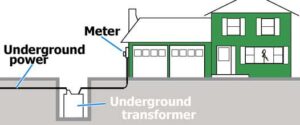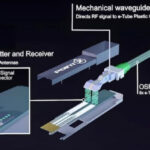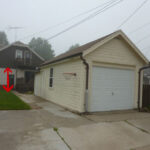Bringing underground power lines to your house is one of the safest and most visually appealing ways to connect your home to the electrical grid. Compared to overhead lines, underground wiring is protected from weather, improves aesthetics, and ensures consistent power delivery with fewer interruptions.
In this article, we’ll explain how to bury power lines to a house, the materials you’ll need, safety standards to follow, and the best practices for a long-lasting underground electrical service.
1. Why Choose Underground Power Lines for Your House?
Many homeowners and contractors are switching from overhead to underground systems for several key reasons:
✅ Safety: No exposed wires or risk from falling trees or storms
✅ Reliability: Less affected by weather or physical damage
✅ Aesthetics: Clean and modern appearance with no visible cables
✅ Longevity: Properly installed underground cables can last 40–50 years
✅ Low Maintenance: Once buried, cables require minimal upkeep
Whether you’re building a new home or upgrading an existing electrical connection, installing underground electrical service is a smart long-term investment.
2. What You’ll Need for Underground Power Cable Installation
To safely and effectively bury power lines to a house, you’ll need the right cables, conduits, and tools. Here’s a breakdown of the most common components:
| Component | Description | Example/Type |
|---|---|---|
| Cable Type | Carries power underground | UF-B cable, USE-2 cable, or armored cable |
| Conduit | Protects the cable from moisture and impact | PVC or HDPE conduit |
| Conduit Fittings | Connect and seal conduit ends | Couplings, elbows, bushings |
| Warning Tape | Marks cable location in trench | Red or yellow “CAUTION – ELECTRIC LINE BELOW” |
| Junction Box or Meter Base | Connection point for electrical service | Weatherproof rated enclosure |
| Backfill Material | Protects cable and allows drainage | Sand or fine soil |
3. Cable Options for Underground Power to a House
Selecting the correct cable type is critical for performance and safety.
Here are the most recommended cable types for underground power line installation:
(1) UF-B Cable (Underground Feeder Cable)
Designed for direct burial without conduit
PVC insulation and moisture-resistant outer jacket
Common for 120/240V residential circuits
(2) USE-2 or RHH/RHW-2 Cable
Single-conductor, suitable for underground service entrances
Often used in conduit systems
Excellent UV and moisture resistance
(3) Armored Cable (SWA or STA)
Provides mechanical protection from rocks and soil pressure
Common for high-load or long-distance installations
💡 Tip: Always match cable size (AWG) with the amp rating and distance of your circuit to prevent voltage drop.
4. How to Bury Power Lines to a House: Step-by-Step
Below is a simplified underground power cable installation guide for residential applications.
Step 1: Plan and Obtain Permits
Contact your local utility provider and electrical inspector.
Confirm depth requirements (typically 18–24 inches for conduit, 24 inches for direct burial).
Step 2: Dig the Trench
Use a trenching machine or manual shovel.
Trench depth depends on local code and installation type.
Keep a consistent slope for proper drainage.
Step 3: Lay Conduit or Cable
If using conduit: Run PVC or HDPE pipe from the service pole to the house.
If using UF-B cable: Lay directly on a sand bed (4–6 inches thick).
Avoid sharp bends or stress on the cable.
Step 4: Add Warning Tape
Place warning tape about 12 inches above the cable to alert future excavators.
Step 5: Backfill Carefully
Cover cable with soft soil or sand before using native soil.
Compact lightly to prevent future sinking.
Step 6: Connect to Service Panel
Terminate the cable in the meter base or main breaker panel.
All connections must be made by a licensed electrician.
5. Underground Power Line Depth Requirements
Typical burial depth guidelines (check local codes before installation):
| Installation Type | Minimum Depth | Protection Required |
|---|---|---|
| UF-B Direct Burial | 24 inches | None |
| PVC Conduit (120V Residential) | 18 inches | PVC Schedule 40 |
| Rigid Metal Conduit | 6 inches | Steel or Aluminum |
| Low Voltage Lighting | 6–12 inches | PVC or none (if rated for burial) |
6. Underground Power Line Diagram
Here’s a simplified underground power to house wiring diagram:

underground power to house wiring diagram
This layout ensures electrical safety, easy maintenance, and compliance with national wiring codes (e.g., NEC in the U.S.).
7. Safety Tips for Underground Electrical Service
⚠️ Never work on live circuits.
Always de-energize the system before handling cables.
Other important safety notes:
Use GFCI protection for outdoor or damp areas.
Avoid running cables near gas or water pipes.
Use only UL-listed or certified cables rated for underground use.
Schedule an inspection before energizing the system.
8. Cost Considerations
The cost to install underground power lines to a house varies depending on:
Distance from the power source
Cable type and size
Conduit material
Labor and trenching method
On average, the cost ranges from $10 to $25 per linear foot, including materials and labor.
9. Advantages of Underground Power Service
Fewer Outages: Protected from wind and storms
Safer for Households: No exposed wires or fire hazards
Long Lifespan: With proper installation, cables last for decades
Clean Appearance: No overhead poles or cluttered lines
Low Maintenance: Reduced risk of accidental damage
10. Conclusion
Installing underground power lines to your house ensures safe, efficient, and long-term electrical service. With the right underground power cable construction, correct burial depth, and licensed installation, you can enjoy a cleaner look and greater reliability for years to come.
⚡ Reliable Underground Power Cables from TOT Wire & Cable
At TOT Wire & Cable, we supply high-quality UF-B, USE-2, and armored underground cables designed for residential, commercial, and industrial power systems.
Our products are tested for durability, insulation strength, and long service life — ensuring safe underground performance even in harsh conditions.
📩 Contact us today for expert recommendations or to request a quotation for your underground power cable needs.





